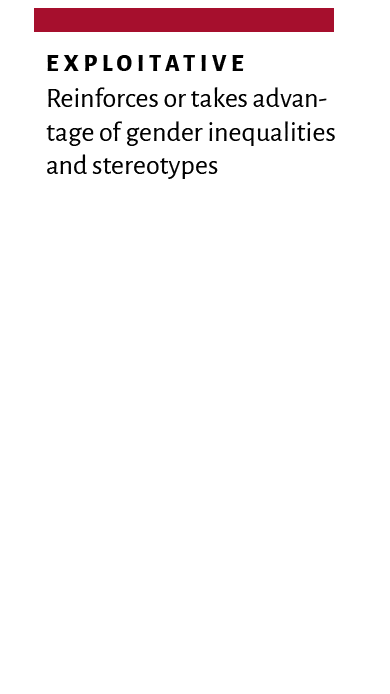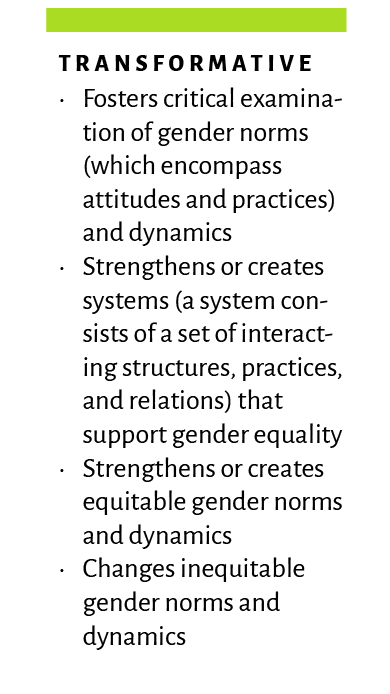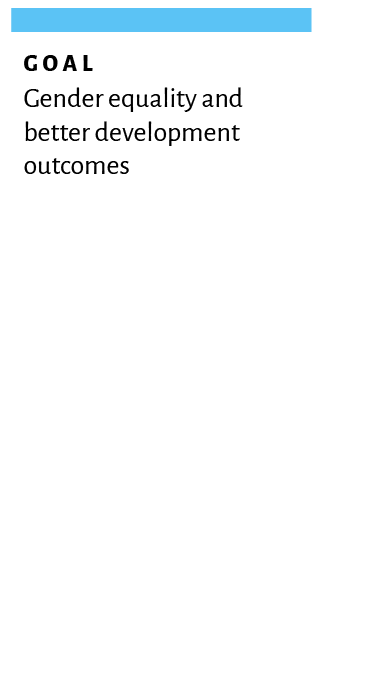Overview
Sexual and reproductive health projects vary by design, implementation, and evaluation.
- Researchers investigate different questions
- Policymakers design and implement effective policies
- Health workers seek to address unmet needs in their communities
While several factors influence the design, implementation, and evaluation of a sexual and reproductive health intervention, projects should always use gender integration strategies to maximize their ability to improve health outcomes and promote gender equality.
The Continuum of Approaches for Gender Integration
The IGWG has adapted a continuum developed by Geeta Rao Gupta, former president of the International Center for Research on Women, to understand how gender is approached in various projects.
It can be used by designers and implementers in planning how to integrate gender into their programs/policies.
The conceptual framework will be discussed in two parts:
-
- Level of consideration for gender integration in the design, implementation, and evaluation of a reproductive health program/activity (gender blind – gender aware)
- Project categories: the continuum (exploitative – accommodating – transformative)
Source
Gupta, 2000; IGWG 2013.
Gender Blind and Gender Aware
Gender blind and gender aware refer to the degree to which a project or activity considers gender.
Gender blind ignores:
-
- The set of economic/social/political roles, rights, entitlements, responsibilities, obligations, and power relations associated with being female and male
- Dynamics between and among men and women, boys and girls
Gender aware examines and addresses these gender considerations and adopts an approach along the continuum
All SRH projects should strive to be gender aware. Gender blind projects are missed opportunities for improving health results and advancing gender equality.
Advancing gender equality should be a priority during the design, implementation, and evaluation of a program or activity.
Project Categories: The Continuum




Gender-aware programs/policies are expected to be designed with gender accommodating or gender transformative intentions in order to move the project community closer to the end goal of gender equality.
Programs/policies may have multiple components that fall at various points along the continuum.
Using the Continuum in Program Planning
You can apply the continuum to your project or intervention to determine if what you are planning is gender blind or gender aware and if gender aware, exploitative, accommodating, or transformative. If your project is gender blind or gender exploitative, then you should rethink how you are trying to achieve your project objectives and revise your approaches.
The Health Communication Capacity Collaborative (HC3) developed a checklist for using the gender equality continuum to assess the integration of gender in programming. The checklist can be used during initial program design of a new program or while re-planning for existing programs. It can also be used at the evaluation stage to understand how gender aspects of the program may have influenced results. For this checklist, see page 21 of the Addressing the Role of Gender in the Demand for RMNCH Commodities: A Programming Guide.
- Example from the field
In various countries, like Kenya, Rwanda, Tanzania and Zambia, prevention of mother-to-child transmission of HIV (PMTCT) policies encourage male involvement to get tested for HIV and participate in antenatal care by encouraging women to bring their partners to the health facility in succeeding visits. Health providers send letters inviting partners to the next antenatal care visit where men are counseled and tested for HIV as are women. However, on many occasions, the programs have ended up being exploitative, as providers have misunderstood the policy and have refused services to women who don’t come with a partner, or prioritize women who come with their partner. Closely monitoring how the program is implemented can help you to ensure the program is accommodating, if not transformative.
To make this intervention more accommodating, providers should:
-
- Ensure equal access to PMTCT, antenatal care, family planning, and the range of services regardless of whether the partner is present (and not just engage men to be tested for HIV).
- Encourage male partners to be involved to facilitate discussions and joint decision-making with respect to the above.
To be transformative, providers can be trained and supported to engage and enlist men not only to be tested for HIV but also to be engaged and supportive partners in antenatal care, birth planning, and postnatal care, e.g., kangaroo father care. Kangaroo care is a method of holding a baby that involves skin-to-skin contact.
"First, Do No Harm"
 At a minimum, health and development projects should strive to “do no harm” with respect to the well-being of all beneficiaries and every aspect of their lives.
At a minimum, health and development projects should strive to “do no harm” with respect to the well-being of all beneficiaries and every aspect of their lives.
All USAID-supported projects are required to avoid exacerbating gender inequality.
There is no viable rationale for designing a project that deliberately exploits gender inequality in pursuit of health outcomes.
Reproductive health projects that fail to acknowledge gender are missing an opportunity to account for the relationship between gender equality and improved health outcomes.
Gender-accommodating projects may be an appropriate short-term approach under certain circumstances (i.e., limited resources or community buy-in for gender integration).
The goal is to challenge project managers to promote projects/activities that transform gender norms and relations in order to advance gender equality.
Review: IGWG Conceptual Framework
In summary, the IGWG conceptual framework illustrates the following key points:
-
- The degree of consideration for gender integration during all phases of a sexual and reproductive health program—from design to evaluation—affects how a program addresses gender norms as it attempts to achieve a desired health outcome.
- Gender-blind approaches are unacceptable. They can lead to exploitative or accommodating projects, but it is unlikely that minimal consideration for gender will result in a gender transformative program.
- Gender-aware consideration may result in a project that lies anywhere along the continuum. For example, projects may purposefully exploit an existing gender norm instead of promoting gender equity, explicitly seek to transform gender norms, or result in an intervention that lies somewhere between these extremes.
Program/policy planners and managers should follow two gender-integration principles:
- Under no circumstances should programs or policies adopt an exploitative approach
- The overall objective of gender integration is to move toward gender equality
These materials were adapted from the Global Health eLearning Center, U.S. Agency for International Development.



